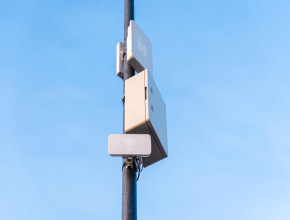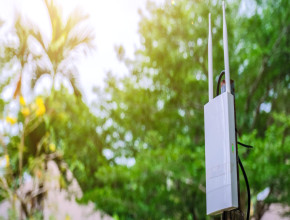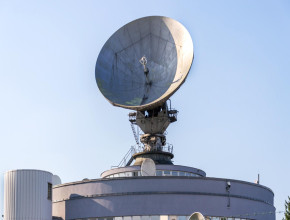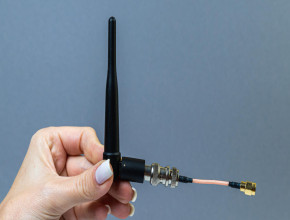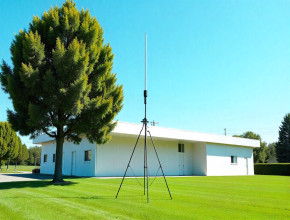
Have you ever wondered how a high-flying drone camera provides a real-time video feed to an operator? The reason lies in a powerful drone antenna. For applications such as aerial photography and live streaming, the drone antenna provides uninterrupted and real-time visuals by ensuring strong communication between the drone and the operator. In this guide, we will understand the essence of drone antennas and explore the different types of drone antennas, applications, and more.
What is a Drone Antenna?
A drone or UAV (Unmanned Aerial Vehicle) antenna plays a vital role in making connections between a drone, its remote control, and other devices and systems. This device facilitates the sharing and reception of real-time data through radio waves. The unique capabilities of the antenna allow the drone to function properly for navigation, data transmission and operation of onboard systems. The primary purpose of a drone antenna is to make wireless communication between the drone and its remote control, as well as other devices or systems. For example, an FPV drone antenna allows the operator to see what the drone sees in real-time.
What is the Range of a Drone Antenna?
There are various antennae warring groups. Omnidirectional drone antennas are used to transmit and receive signals in all directions. On the other hand, directional drone antennas focus the signal in a specific direction. Typically, a drone antenna can send and receive signals from a few hundred meters to several kilometres.
Most consumer-grade drones work in the 2.4 GHz frequency range. These come with a satisfactory balance between range and signal penetration. However, it can not perform well in crowded electrical devices such as WiFi routers or Bluetooth devices. When it comes to professional-grade drones, they operate on the 5.8 GHz frequency. This range is ideal for low interference but has a short range and weak signal penetration.
However, many environmental conditions affect the range of UAV antennas. For example, obstacles such as buildings, trees, and mountains may interfere with the signal and you may not be able to achieve high range.
Types of Drone Antenna?
Different shapes and sizes of drone antennas classify them into different types. Each UAV antenna is used for specific purposes. Below, we have described the major types of drone antennas and their main characteristics:
Dipole Antenna
A dipole antenna is a common type of drone antenna that we can use on WiFi and drones. This device comes in a small and medium-size structure. And it features two equal-length conductive electrons made of metal rods arranged in a straight line. Dipole antennas are typically omnidirectional antennas. That means they are used for 360-degree communications. These wireless solutions are generally cost-effective antennas for transmitting and receiving radio signals. You can use dipole antennas to establish communication between the drone and its remote control. It is also used for video transmission and data transfer.
Patch Antenna
A microstrip or patch antenna is a highly directional antenna. They are mainly used to focus the signal in a specific direction. This device consists of a rectangular sheet of metal placed over a larger sheet of metal called a ground plane. The patch antenna is a low-profile wireless solution that makes it an ideal solution for drones and space vehicles. Patch antennas are used for wireless communications, GPS navigation, video transmission and data transmission.
Helical Antenna
A helical antenna is one of the important UAV antennas. The design of this antenna is small and straightforward, making it the perfect solution for setting up a drone. Helical antennas can function as omnidirectional and directional antennas. It has a helical structure which plays an important role in creating circular polarization. This unique capacity helps users to create uninterrupted communication in various situations. Helical antennas help send live video footage from the drone to the ground station. It helps in data transmission, communication with other drones or systems, and more.
Yagi-Uda Antenna
Yagi-Uda antennas are highly directional antennas commonly used in drones. They provide transmission and reception over long distances. This wireless solution has high gain potential making it the ideal solution for sending and receiving connections over long distances. Yagi antennas are composed of a driven element, a reflective element, and one or more director elements. This wireless solution helps in long-distance video transmission, data communication and remote control.
Parabolic Dish Antenna
A parabolic dish antenna is a very popular drone antenna. It is a directional antenna and ideal for long-distance communications. The unique feature of the antenna is that it has a curved reflector that is used for focusing signals in a specific direction. Parabolic dish antennas function as FPV drone antennas operated by remote control or from a ground station. The antenna plays a vital role in transmitting high-quality video footage over long distances.
What is a Drone Antenna Used For?
Drone antennas are used for a variety of purposes, from filming to mapping, surveying, and more. There are many applications where FPV Drone antennas play a vital role in establishing wireless communications. Here are some uses of drone antennas:
Video Transmission
Due to the small size of drone antennas, they fit onto the drone and are used to transmit a live video to a remote controller or ground station. The best drone antenna allows users to stream high-quality footage in real time.
Remote Control Signal
Drone antennas help the remote controller to move the drone in different directions and control its various functions. The operator can operate the drone manually for film production, photoshoots, etc.
GPS Reception
Many drones use GPS to determine their location and navigate accurately. Drone antennas create connections with GPS satellites that help the drone maintain its position. And the drone can also share its location with ground stations.
Signal Quality Improvement
In remote areas where signal quality is very poor. In such areas, drone antennas can help improve signal strength and stability. The antenna eliminates stale connections and creates seamless and uninterrupted connections between the drone and the remote controller or ground station.
Final Words
Drone antennas are essential devices for creating reliable connections between drones and controllers or other devices. Today, the demand for drone antennas is increasing more rapidly than ever. These state-of-the-art devices help in establishing wireless communication and allow users to use them for real-time video recording, image capture, live streaming, sharing information, and more.

